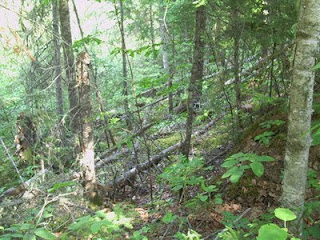This essay was published in February 2007 by Superior Sentinel.
The world got a chance to dry out a bit before the Era of the dinosaurs came and passed in three distinct periods ending with the beginning of the Cenozoic Era, the last Era on Earth and we live in it - seventy-five million years later.
Just to be confusing scientists vary on names they use to divide up this humongous chunk of time, either six Epochs or, two Periods and four Epochs, before they get to the mundane Recent of twenty-five thousand years ago.
Glacial scouring of bedrock in Northern Ontario left depressions conducive to the growth of wetlands and subsequent bogs have sequestered carbon for around eight thousand years. Not exactly "Presto!" but, we have peat.
Sphagnum mosses, sedges, rushes and reeds form the living top layer of a bog, living plants that use the energy of light to convert carbon dioxide to organic matter,
Peat is now considered a renewable resource. You may have to wait a few thousand years for the full depth of peat to come back but the re-vegetation process of a peat bog can start as soon as five to twenty years. In fact in Canada peat is termed a sustainable natural resource as each year fifty million tons accumulate in our natural environment and we only harvest about eight hundred thousand tons.
It's been over thirty years since the publication of the Geological Survey of Some Peat Deposits in Selected Areas: the Districts of Thunder Bay and Kenora, Nipissing, Sudbury and Algoma. Eighteen sites were tested between Nipigon and Ignace. The Upsula area had the most potential followed closely by Lyon Township so it is no surprise that the Upsula area is currently being sampled by Peat Resources Limited of Toronto with a view to creating a peat fuel industry here in Northern Ontario. Analytical work confirmed that the peat in the samples has a very low sulphur content and no mercury - twenty million tons in that cluster of bogs, Twenty years at least of employment opportunities.
The Geological Survey thought there might be fifty years employment in that area (Upsula) and thirty-eight years in the Lyon Township complex. Time will tell, if they don't get bogged down in the Class Environmental Assessment process or stagnated by environmental activists. (Most of Lyon bog is now a Conservation Area.2011)
Finland and Sweden have asked the International Panel for Climate Change to recognize peat as a biomass fuel not a biofuel (wood) or fossil fuel (coal). Previously peat had been classed as a fossil fuel and became all tangled up in the Greenhouse Gas carbon dioxide emission equation.
Dead or alive peat bogs are tangled up in the carbon cycle, they hold one third of the world's sequestered carbon, and that puts us into the Kyoto Accord recipe for a healthy planet.
When living things die they decompose. In decomposition the carbon is returned to our atmosphere as carbon dioxide unless it is in an oxygenless place i.e. submerged as in a bog, then the carbon stays sequestered and the peat bogs are termed "carbon sinks".
Ontario has twenty-nine million hectares of wetlands scattered throughout seventy million hectares of forests ( another carbon sink). Now, as bad carbon dioxide is as a "Greenhouse Gas", living bogs continue to emit a 23 times more potent gas, methane. Methane is the 'excuse me' gas of burping cows and growing termite colonies and mysterious oceanic belching. Wetlands do account for the Dagwood portion of that pie graph.
FOR PEAT'S SAKE
Already a large headline in the Chronicle Journal (Thunder Bay) of Friday, November 17th, 2006, page A-6, blared out " Peat energy: the flip side of the coin" ...written by a Lakehead University professor of Chemistry. He quotes Chemical Abstracts and citations that are available to environmental professionals about peat and mercury and chlorine. Sure, the abstracts are there on the Internet and they do mention peat and mercury and chlorine but the peat in question is in New Brunswick or Chile or Indonesia. He does say it is up to us, the People of Ontario, to speak up. So I am.
Peat can be used to make multidimensional industrial products besides its use as a fuel or horticultural peat moss (Canada supplies 22% of the world's horticultural peat). Depending on the process peat can be transformed into solids, liquids or gases: coal, tar, activated carbon, raw phenols, raw waxes, raw resins, synthetic waxes, alcohol, fatty alcohols, fatty acids, Oxalic acids, Crude oil, oil products, Hydrogen gas, Methane, Methanol, and ammonia.
I believe this is the best time in our lives for Northern Ontario to start processing peat. All industry has to follow The Best Available Control Technology, the Best of Every Means Possible and then have an AFTER PLAN. That is, how they will rehabilitate the land.
Canada has just come out with a Clean Air Act (Canada Gazette Oct. 26, 2006...and edit note...It seems to have disappeared) that has a guiding principle to promote investment in the development and deployment of new technologies.
Carbon Credits can be earned by reducing Greenhouse Gas emissions and Peat fuel has the edge on Canadian and U.S. lignite with one tenth the amount of sulphur and virtually no mercury.

No comments:
Post a Comment